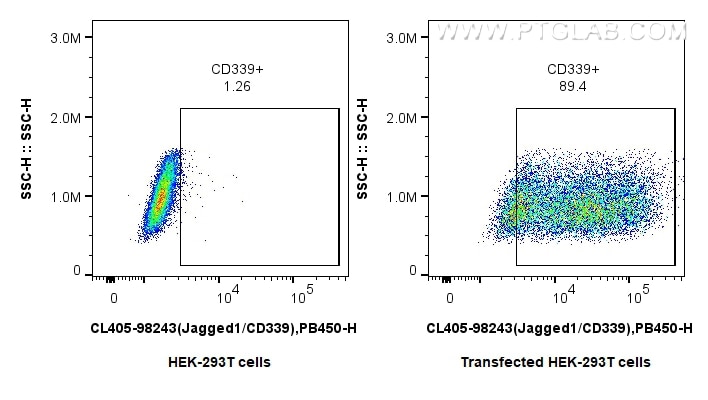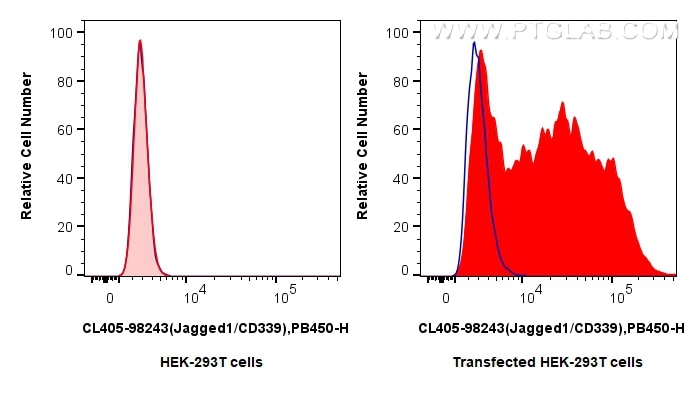Tested Applications
| Positive FC detected in | Transfected HEK-293T cells |
Recommended dilution
| Application | Dilution |
|---|---|
| This reagent has been pre-titrated and tested for flow cytometric analysis. The suggested use of this reagent is 5 ul per 10^6 cells in a 100 µl suspension or 5 ul per 100 µl of whole blood. | |
| Sample-dependent, Check data in validation data gallery. | |
Product Information
CL405-98243 targets Jagged1/CD339 in FC applications and shows reactivity with human samples.
| Tested Reactivity | human |
| Host / Isotype | Rabbit / IgG |
| Class | Recombinant |
| Type | Antibody |
| Immunogen | Recombinant protein Predict reactive species |
| Full Name | jagged 1 (Alagille syndrome) |
| Calculated Molecular Weight | 1218 aa, 134 kDa |
| GenBank Accession Number | BC098393 |
| Gene Symbol | Jagged1 |
| Gene ID (NCBI) | 182 |
| Conjugate | CoraLite® Plus 405 Fluorescent Dye |
| Excitation/Emission Maxima Wavelengths | 399 nm / 422 nm |
| Form | Liquid |
| Purification Method | Protein A purification |
| UNIPROT ID | P78504 |
| Storage Buffer | PBS with 0.09% sodium azide and 0.5% BSA , pH 7.3 |
| Storage Conditions | Store at 2-8°C. Avoid exposure to light. Stable for one year after shipment. |
Background Information
Jagged1 (JAG1), also known as CD339, is a type I, membrane-anchored, multi-domain protein and a ligand of the Notch receptor (PMID: 15358557). Jagged1 is composed of a relatively small intracellular domain, a transmembrane domain, and a larger extracellular component containing a cystine-rich region, 16 EGF-like repeats, a DSL domain, and a signal peptide (PMID: 15358557; 26548814). It is widely expressed throughout mammalian development, across many tissues and developmental stages (PMID: 26548814). The Jagged1-NOTCH interaction can trigger the Notch signaling and activate transcription factors that play key roles in cell differentiation and morphogenesis.
Protocols
| Product Specific Protocols | |
|---|---|
| FC protocol for CL Plus 405 Jagged1/CD339 antibody CL405-98243 | Download protocol |
| Standard Protocols | |
|---|---|
| Click here to view our Standard Protocols |





